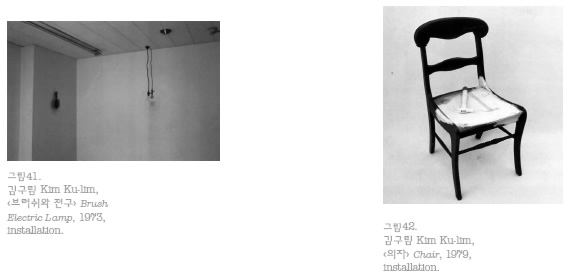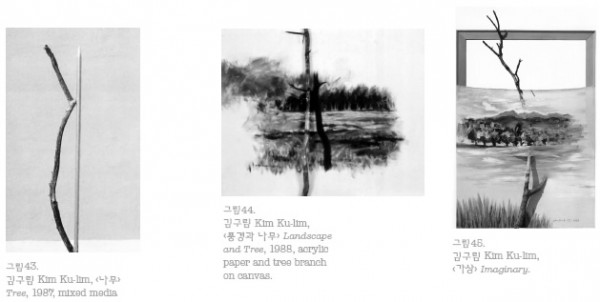Kim Ku-lim’s ‘Deconstruction’
페이지 정보
작성자ART 댓글 0건 조회 3,799회 작성일 19-02-25 18:22본문
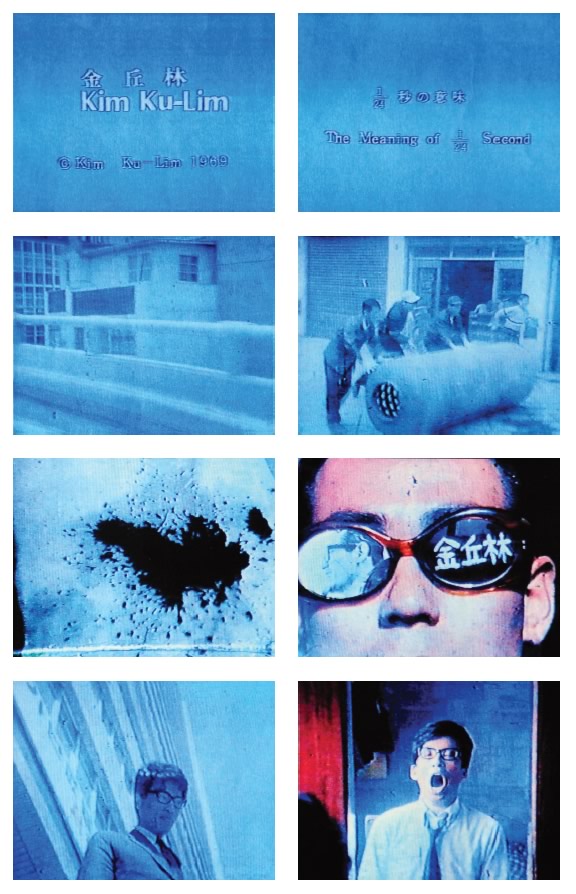 1 Foreword
1 Foreword
I recall myself seeing Kim Ku-lim’s works back in the 70s as a college student. At that time, I was into Chang Uc-chin, frequently going to Chun Kyung-ja’s exhibitions, and I was also familiar with the fact that monochromatic paintings, such as that of Park Seo-bo, were being actively distributed throughout galleries. His works at that time caught my attention; mostly due to the ‘difference’ of them. Thinking back, the reason for such ‘difference’ lies in the disparity between Kim’s works and the then contemporary mainstream. Viewing the 70s as a heyday of modernism, being represented by abstract paintings, Kim Ku-lim stayed outside of the mainstream, which in turn led me to see his works quite differently.
In his difference, I find a state similar to ‘deconstructivism’ which I recently came to learn of. To me his works seem as if they are diagrams, revealing the ways of thinking of deconstructivists; in particular Jaques Derrida, an exemplary figure in the very field. Of course Kim had no knowledge of deconstructivists or Derrida, nor did he attempt to gains such knowledge. However, that is not the issue. What’s important is that the consistency found in Kim’s works, which by the way have no consistency, has an aspect of dismantling the frame of modern philosophy and its ultimate form, modernism, and that this very point stands on the same horizon with recent trends of deconstructivism. It can’t be mere coincidence that Kim’s works, which continuously maintained difference from the contemporary artworks made during the modernism era of Korean art, has a commonness with deconstructivism, which blatantly challenged modern philosophy of the West.
‘Deconstructivism’, in a word, is to break the way of thinking that has been the framework of western history of thoughts since Plato, especially the logos-centricism. In contrary to deconstructivists, who used text as a measure of such deconstruction, Kim Ku-lim took figure as his tool. Thus I plan to take the deconstructivists’ text to provide an explanation of Kim’s figures. As obvious as it would be, I would like to note that this is just one of the paths to approach his works. It is also an obvious premise that art and philosophy, each with its unique semantic system, have un-exchangeable parts between them. Therefore, one might come across certain aspects which may not be explained by deconstructivism and even stand against such theory. Here I plan to focus on the shared aspect between Kim’s works and deconstructivism.
The point where Kim Ku-lim’s works and deconstructivism meet is the point where modern philosophy questions the very method of ‘signification’. Deconstructivists shake down the major premise of modern way of thinking—signs uttered by single and consistent subject contain equally single and consistent meaning, which are then received by another single and consistent subject. By denying the logic of ‘identity’, they deconstruct the very process of signification.
Kim Ku-lim’s works also show a similar characteristic. The reason his works are different from those of his contemporary mainstream artists is not because of his making different visual signs with different meanings, but because of his different way of signification. His method, simply put, is speaking of something that is not—in other words, ‘thought through negation’, or as Kim Hyung-hyo puts, the philosophy of subtraction.3 If the signs made by contemporary mainstream artists, such as monochromatic painters, are claiming that ‘art is this’, Kim’s works could be seen as saying that ‘art isn’t this’. He cuts off the very string of identity; thus such utterance has no choice but to be sustained endlessly, and its meaning would follow to be delayed indefinitely. These meanings, in modern philosophy’s way of thinking, are equivalent to non-existence, and so such ways of signification is not different from the deconstrucion of meaning.
This deconstructive tendency of Kim Ku-lim is not confined to his works made in the 70s; rather, it is shown throughout his whole career, beginning from the mid-60s. As such, it is natural that he has been constantly positioned outside of Korea’s modern art which followed modernism as an exemplary standard. Especially, during the 70s, in which the modernism surfaced as a mainstream trend, Kim’s difference stood out even more. Therefore, this article, while encompassing Kim’s whole career, will mention more of his works from the 70s.
Because the main subject of this article is Kim Ku-lim’s works, and not deconstructivism philosophy, only a handful of necessary concepts—most appropriately, concepts used by Derrida—will be borrowed to better explain Kim’s works.4 I selected Derrida because of his achievements in deconstructing language, the very tool of philosophy, and thus, in my view, he is the most fundamental deconstructivist who shook the roots of metaphysics. He is also the one who observed deconstruction in spatial art. Derrida argued that deconstruction is equivalent to continuously erasing self-identity, in other words spacing (l’espacement); he described his writings in a spatial (or architectural) way, and also paid special interest to spatial art such as architecture, sculpture and painting.5 It is because spacing, in his terms, will be best revealed through concrete experiences of specific spaces. To Derrida, everything is deconstruction, but spatial art is a better example to show that. Among those examples, to me, Kim Ku-lim’s works seemed to be an appropriate choice.
As is Derrida’s writings, deconstruction is a denial of analysis and synthesis, and writings on deconstruction are also deliberate circular reasonings which evade analysis and synthesis. Similarly, Kim Ku-lim’s works, rather than developing in a progressive way, also reflect each other and circulate. However, my intention is to accept the contradiction of taking analysis and synthesis, an anti-deconstructive method, to explain deconstruction. One reason is because I cannot break away from my belief, or prejudice, that only analysis and synthesis may deliver even the meaning of deconstruction, and the other is my inability to free myself from existing habits of writing. In the following, I will deliberately separate the aspects of artist, work, artistic concept in Kim Ku-lim’s works, which circulate in an inseparably interwined manner, and show their deconstructive aspect. Most of my work will be on examining the conditions which loosen the link between subject and work of art, signifier and signified, and specimen and concept.

2. Death of the Artist-Subject
The author is dead—we don’t even know who she or he is—but it remains [as a surplus].
Kim Ku-lim’s career crosses many different genres, making it hard to believe to have come from a single author, and no consistency may be found among his works. He laid his hands on nearly all fields in arts: plane and solid works, object, engraving, ceramics, embroidery, dyeing, photography, video, installation, land art, performance, mail art, dance, film, stage design, theatrical costume and so on. Kim’s catalogue, wandering around disparate and severed signs, precludes us from tracking down the ‘sole author’ who stands behind his works of art. His works, with links between work of art and its author is loosened, denies the idea of the author as a consistent being. Kim, who circulates between various personae, without showing any consistent direction, positions himself far away from the modernist model of an artist; those who consistently imprint themselves in their individual styles, following the logic of linear evolution. As stated by the Kim Ku-lim, that he is in pursuit of art as a nameless structure,7 Kim is determined to work as an unknown author, and thus demonstrates the ‘death of the subject (or the author)’ which was announced by the deconstructivists.
Death of the subject—or the author—may be witnessed from the many different artists’ voices that echo in Kim Ku-lim’s works. Through his works, in which the shovel used by Marcel Duchamp (picture 1, 2), can used by Jasper Johns, Piero Manzoni’s women as a living sculpture (picture 3, 4), Hans Haacke’s fluid sculpture, Christo and Jeanne-Claude’s wrapping works and David Salle’s new painting all appear, Kim plays the “the other in us”8, a concept used by Derrida. Kim may or may not be aware that he is imitating others’ voices. Nevertheless, one thing obvious is the fact that he does not avoid it compulsively.9 To Kim, being free from modernist fanaticism towards the myth of originality, appropriation, which would fall into the category of plagiarism, a serious crime for modernists, is one of the just work styles. Even more, since his own works are also objects of appropriation, he often revives his past works.
Attitude of Kim Ku-lim, revealed through his works, in which signs of ‘appropriation’ are created and the presence of a consistent and sole author is deconstructed, stand in a very ‘different’ spot from monochromatic painters of his period, who were based on the philosophy of presence. Supposing that monochromatic painters attempted to create signs as an evidence of their presence, Kim was more of an author who created signs to identify his absence. Monochromatic painters, by repeating identical paintings, imprint the consistent being of an author; especially, they try to present the author’s presence through indices of his/her ‘body’. On this, Kim Ku-lim’s works show the impossibility of such body. As a simple example, in Kim’s works, voluntary brush strokes, which is used as a sign of the author’s body in monochromatic painting, is placed side by side with those that betray the very stroke—objective letters, mechanically drawn lines and mechanically made objects—to erase the effect of presence. After all, he is showing what Derrida called ‘nonpresence’10, the impossibility of identification, with his paintings.
According to Derrida, Vincent van Gogh’s brush-touch, though seemingly having the effect of presence, may be identified neither with Gogh’s body nor Gogh himself. What it means is that, because Gogh’s body is constantly dislocated during the process of performing his body, body is not presence but an experience of frame. We imagine the authors’ body to be present and the same for works of art, but those imagines are mere unstable attempts to fix objects; rather, they represent the impossibility of cohesion, and the fear towards such impossibility. Thus, as Derrida stated, “presence would mean death. Should it be possible... there would be no Gogh, his works and our experience of his works.” If it were to be possible, it is possible only to the extent where “presence exists but does not converge... the being there is only made possible on the basis of the effects of traces dislocating itself.”
If an author called Kim Ku-lim exists, it may be only possible through the act of constant self-dislocation; an act of continuous reframing while denying the presence of himself. In that sense, the author is the remains which already have been deconstructed, or at least destined to be deconstructed. Kim’s works, composed of heterogeneous natures coming from juxtaposed figures on the screen and discontinuity between each pieces, are the signs of such remains. Compared to monochromatic painters who revive dead or nonexistent authors, Kim Ku-lim actively reveals the impossibility of the very author’s existence. To Kim, the author-subject is, using Derrida’s words, “formed only through self-division, self-spacing, waiting and self-delaying”.
This subject is the one that was put aside and left at the margin of traditional philosophy, under which speech, thought and existence were seen as one. To Kim Ku-lim, a work of art is not readily equivalent to thought, and thought is not automatically identified with the author. His works are, in a sense, ‘keeping distance’ between these factors, and it is the ‘context’ which works as a separator. In this sense, the artist-subject is a series of positions which are drift on such context. Therefore, the signature—an act of the author giving his/her name to the work of art—requires countersignature as a premise. Countersignature, a signature from the outside, precedes the signature from the inside.13 Works of art of an author are not originally identical; that sameness is made by ‘contexts’ such as art museums or the art world.
This attitude is also found in Kim Ku-lim’s words. His statements such as, “what am I? I am the element of sense which is stimulated by all beings that surround me. I am the image, vertical and horizontal, of how I see you and how you feel me”14 or “an author finds himself, not as a creator, but as a part of this world”15, evoke the positions of authors that have been proliferated as a matrix of signs. Kim’s words and works are, just as Derrida thought of, to show that “subject is neither the master nor the author of a signifier... even if there was a subject of signifier, it exists merely to follow the law of the signifier.”
The artist-subject, as shown by Kim Ku-lim, is a subject that has been proliferated into the context—a combination of texts. All first person views are a illusion, and every origin is demonstrated to be an abstract point, distant from the concrete world. Kim, who moves around various positions, namely ‘artists’, reveals that, because all subjects are woven into the world of texts that already transcends the ego, every creation is in fact a re-creation and everything is a copy of everything. He is, rather than the subject of work of art, the “subject effect”.17 In a world of text, similar to a woven textile, the artist ‘subject (le sujet)’ is but an ‘overstitch (le surger)’18 of such textile. In the end, Kim is fulfilling what Derrida said about “nothing outside of the text”.
3. Game of Différance
“Signifier doesn’t contain an identical place in itself. It lacks of its place.”
As the subject is not a consistent and unique presence in a world of text, the sign created by that subject is also neither consistent nor unique. Just as the ring, that links the subject and its spoken signs, is a sort of an illusion, the ring that links the signifier and the signified is also an illusion. Similarly, in Kim Ku-lim’s works, the link between figure and meaning is also loosened. Artist-subject, as well as its signs—author’s works of art—are also deviant from the myth of sameness.
In Kim Ku-lim’s words, his works “does not exist perpetually and clearly in a certain space. They are something obscure, that repeatedly appear and disappear like foam bubbles, which seem visible yet invisible and nonexistent yet there.” In his view, figures or objects in works of art are remains that may not be completed; they cannot be identified with anything, and contain and reveal parts that cannot be signified.
These signs as remains belong to what Derrida calls, the world of ‘letters (gramme)’. Derrida’s deconstruction, which begins from the deconstruction of logocentrism, is to reject the phonocentrism of traditional metaphysics in which the presence of a subject that speaks and hears for itself is a prerequisite. Derrida rejects ‘speech’ which is prone to the illusion of presence. Rather, he focuses on ‘writing’ as a ‘trace’ of such presence, and suggests grammatology (la grammatologie)—‘thought without meaning’ that is carried by writing. Writing is a trace that contains ‘something different’ in ‘something identical’. Similar to ‘pharmakon’, which can be either remedy or poison, writing functions as an affirmation of both sides. Thus, instead of converging towards a single signified, writing slips and slides indefinitely, leaning on or countering repeatedly. In this repetition, “origin’s self-identity and self-presence of the “living present” disappear. What disappears is the center.” Likewise, writing, as opposed to speech, is the signifier which endlessly erases the self-identity. Death of the subject is thus visualized through grammatology.
In order to explain this slippage of meaning, Derrida coins the term ‘différance’. Différance, being a combination of ‘to differ’ and ‘to defer’, is an endless game of signifiers—each of them are spatially different and perpetually delayed—and refers to the very signifiers. It is the dissemination of seeds that are without origin or center; in other words, the chain of meaning effects as opposed to meaning as dissémination. It is the trace which remains and is erased at the same time, as well as the repetition of such traces. Kim Ku-lim’s works can be seen as this kind of writing as différance. Kim’s mention that, “when I draw a cup, I don’t draw the cup in a realistic way, nor do I take an abstract approach. I draw something that doesn’t belong anywhere, something that is similar to cup but is not” is not different from différance.
Just like his words, a game of signifiers, all different from each other, is deployed in his works. Those that especially call for attention are the signifiers of representation in the field of arts. Kim suggests various artistic customs of representing objects.
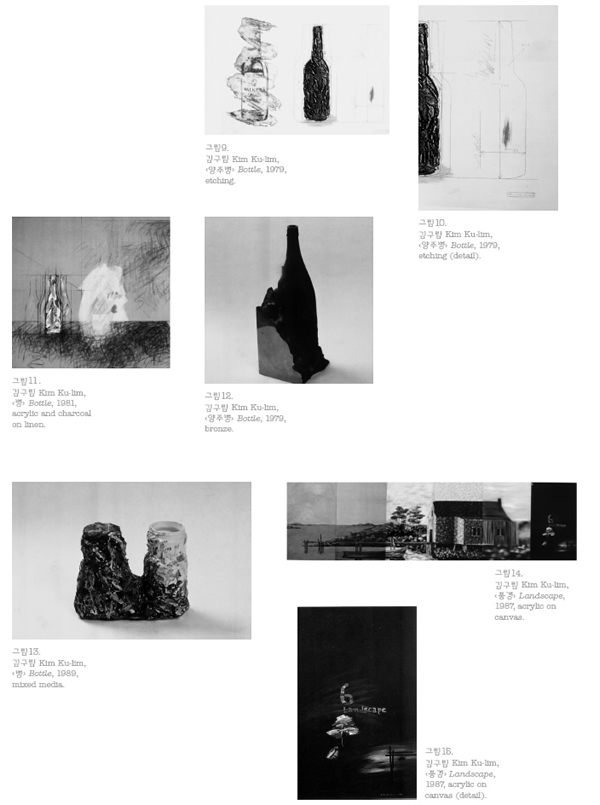
Taking for example the ‘bottle’ that he has been drawing since the 70s, a variety of signifiers are placed side by side in a single piece, or presented through multiple pieces. For instance, in Bottle (1979) (picture 9, 10), the bottle is represented in many different ways: very realistic figurative painting, informel brush strokes and diagrammed graphic. All of these are pictorial signifiers that represent the bottle. Also, the bottle is represented both as a positive space and a negative space, and is being drawn and erased. The word ‘glass bottle’, as well as numerical figures such as width and length are also signs of the bottle. Figures and character signs are placed together in Kim’s painting, and the game of différance is continued through many different signifiers in a single work, with one motif developing into a series of other works: photograph of the bottle is added Bottle (1981), a solid sculpture of the bottle is presented in 1979 (picture 12) and in another work, the real bottle itself is borrowed and used. It can be said that painting and sculpture, illusion and existence, art and signifiers of objects are playing a game in this series of works.
This game of signifiers, as seen by taking the bottle as an example, is deployed throughout Kim Ku-lim’s whole catalogue of works.
First, Kim makes use of various painting signs. A good example would be Landscape (1987) (picture 14, 15) in which he used multiple techniques to paint a single scenery. To paint a scene of a beach with a house, Kim uses schematized line, highly realistic figurative painting, rough expressionistic brush stroke and pointillism for representation, and goes further to use still photo effects captured while moving and even letters written on the scene of a dark and void night. As that letters assert, it is one scene and also six different sceneries, all at the same time.
In this way, not only does Kim Ku-lim juxtapose many kinds of painting signs, he also exposes the differences between each of their signifying processes. In his paintings, many different ways of naming an object exist as a mixture. For example, in Untitled (1981) (picture 16), the character is portrayed as a positive and a negative space—same goes with the chair. A similar painting that was released in the same year also juxtaposes two types of spaces that depicts a chair. Furthermore, the two spaces also exist as a mixture in the character which is portrayed as a blank space and given blurry looks. Still object (1982) is given a relief effect by covering thin sheets of paper on the screen, and its embossed surface is an example of presenting positive and negative space to the letter. In addition, by making the fluidity of air quietly move the surface, Kim visualizes the process of such exchange in a material way. In contrast, signs of such spaces, respectively through existence and absence of their object, designate things. In other words, it is only the direction of signification that is different, and they all have the effect of designating the same thing. Such contrast in the direction of signification is also suggested through drawing and erasing; meticulously ‘drawn’ rose and the rose that is ‘erased’ with a net of lines (picture 19), or the bottle that is ‘drawn’ with rough brush touch and the one that is ‘erased’ with white paint, or else the flower and nude that are realistically drawn, nearly identical to a photograph, and the pencil mark that erases them. In Newspaper (1982), a like of three-dimensional collage made out of pasting newspaper onto a table, a painterly method—drawing and erasing—appears as revealing and concealing.
As such, in Kim Ku-lim’s works, signification processes in opposite directions are put side by side, through which signs deny each other and ultimately reveal the fact that no painterly sign may flawlessly represent an object. According to Kim, by repeating this “overlaying of fiction [signifier]”, “the way ‘drawing’ turns to‘crumbling down’” shows up.
Together with these painterly signs, ‘letters’ are the ones that frequently appear in Kim Ku-lim’s works. Letters, while showing up in all of Kim’s works, continues to play game with the painting. It may become a reference to represented objects, talk about the painting’s size or material, mention the subject, or hint at its time of creation. Above all, it takes a signification method different from that of a painting. In Charles S. Peirce’s terms, it is presented as a ‘symbol’, whose meaning is given by society’s agreement, as opposed to painting which is an ‘icon’ and signified based on similarity.30 Especially, despite the fact that the word ‘glass bottle’ in Bottle (picture 9, 10), or the numerical values, signifying the measurements, are etched upside down, they are nevertheless read properly, thus letting us reconfirm their character of a ‘symbol’. However, on the other hand, that identity as a ‘symbol’ is once again denied. In the above mentioned piece, the letters on the whiskey bottle are indeed ‘symbols’ due to the fact that they are properly read as “Walker’s De Luxe Bourbon”, and thus create symbolic effects. However, considering that those letters are a realistic drawing of the actual brand of the bottle, they are icons based on similarity. In that sense, Kim’s letters lead the thoughts on difference and sameness between their signification and the painting.
This game of painting and letters is more delicately made use of in Landscape (picture 14, 15), in which letters call themselves ‘scenery’—in other words, painting. Here, the letters refer to the painting as a whole, and, at the same time, differentiate themselves from the above mentioned painterly signs. They are identical yet different from the paintings mentioned above. Various colors painted on the number ‘6’ suggest that itself may be the painting, and also signifies each different painting techniques of the panels on the front. Furthermore, to say that there are six, including itself, speaks for the fact that the letters are also a painting of a landscape, thus a painting. Then again, as it is erased by another brush stroke, another painterly sign, it is a letter rather than a painting. While letters are contrasted with the painting, they also explain the painting, become the painting and again become something different from it... this is how the game goes on.
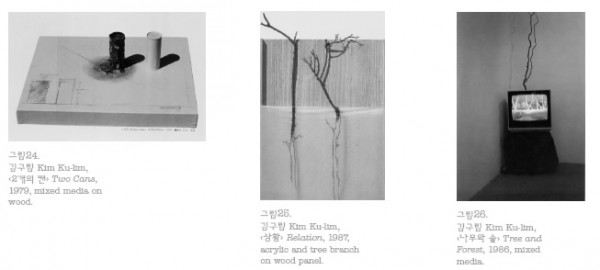
An object may be represented as a solid sign, as well as a flat sign as seen from above examples, and this kind of representation may be found in 2 Cans (picture 24 ) which is a combination of painting and sculpture. Diagram of a can, drawn on the canvas, is being realized—given shape and figure—through the actual can that is put on the canvas. It seems as if the painterly guideline, which tells us to paint, is realized through the can coated with primary colors, and the diagram, which guides the size of the can, is reincarnated as the actual can. Here, flat signs and solid signs exchange meanings by reflecting, supplementing and contrasting with each other. Such game is advanced by reading sculpture as painting and vice versa. A candle, covered in paint or painted in white, is three- dimensional, but its surface is no different from informel or monochrome painting. As touches of primary color and white paint are extended to the canvas’ surface, this kind of ambivalent way of reading becomes further encouraged. In the meantime, the white canvas, that has been used as the surface of the painting, due to its thickness, is also read as cubic sculpture or a stand. Painting and sculpture are pulling down the wall of self-identity by visiting each other in Kim Ku-lim’s works.
Setting the can on a canvas, instead of drawing it on the surface of a canvas, stems from being aware of the question of illusion and reality. Kim Ku-lim, while separating illusion and reality by juxtaposing paintings with real objects, also applies coloring methods—those that create illusion—to real cans, thus going back and forth between them. What happens is, real objects become illusion and vice versa. This kind of ‘situation’ is realized in Situation (picture 25), in which real twigs denaturalize and turn into paintings of twigs; Kim Ku-lim goes as far as to replace the painting of a twig with a video image which is an even more perfect illusion (picture 26). ‘Realistic illusion’ per se is a sign that attests to the inversion of real object and illusion. Painterly images are obviously revealed to be an illusion through illusion—realistic nude figure reflected as an image on the mirror or television. Kim’s painting, with the real nude presented in front of it, is a sort of painterly illustration that speaks about the vague boundary between illusion and real object. It claims that illusion is the one that could be closer to real objects, and that after all, real objects could be an illusion. Photograph—a perfect illusion—and the real object that are juxtaposed in Stone A (picture 28) shows this relationship in a more elaborate way. First, a photograph of a stone and the real stone are juxtaposed and contrasted respectively as illusion and reality. However, as they are altogether photographed again, they become assimilated. After all, illusion and reality are all just one of many signifiers, and thus real objects do not perfectly represent the reality.
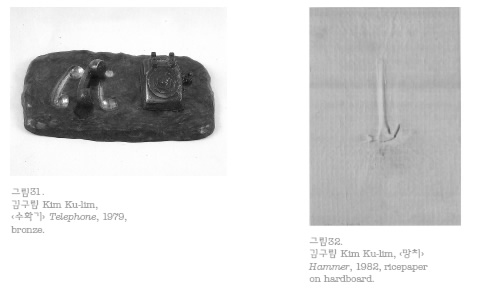
Through Kim Ku-lim’s works, in which each different signifiers are placed side by side, ‘time’ factor is naturally visualized also in a heterogeneous way. First, Kim juxtaposes various positions and images of a same object to represent time as a ‘continuance’. Such methods are, for example, depicting creation (picture 29) and deface (picture 30) of an object and leaving the space where an object was placed on or passed through. Time as ‘continuance’ is juxtaposed with time as ‘moment’; quick brush strokes record the moments of drawing, and handprints on bronze sculptures, the moments of making. Also, while bridging past and present and hinting the future, thus containing the endlessly flowing and changing time, Kim takes vividly painted bottle, complete bronze figure of a telephone and a ball to talk about something unchangeable, namely a perpetual presence. It is the time that belongs to a transcendental and conceptual domain. Kim’s works, in which each different representations of time inter-exchange through intersection, and also deny each other, are not different from, in Derrida’s terms, differance. Kim Ku-lim’s thoughts, as expressed by his words, “beginning is the end, and end is a consecution of beginnings”, are in contact with Derrida’s concept of ‘past-present’—which claims that past is another form of presence.
Kim’s works reveal the many facets of time, such as continuance and moment, past and presence, specific flow and abstract concept, and the signs that represent time are also suggested in various ways. If repetitive figures or traces of objects (picture 31) are an icon of time that visualizes the stream of time, than it should be said that brush touches or handprints are traces of the very work process; in other words, the index of time. On the other hand, these are all illusions of time, and such illusion is once again contrasted through reality. Hammer (1982) not only juxtaposes the present figure with the trace from the past, but shows in real time how its surface actually move as the air moves. The game between illusion and reality, which frequently appears in Kim’s works, deals also the issue of time without exception. His works such as ice sculpture, video art and performance, which actually move or change, are also the results of attempts in putting real time into action. The video piece of 1974 shows mopping of a table, which compresses 50 years—time that takes for the mop to wear out and disappear—into 5 minutes. Here, the video image is an illusion of 50 years of time, and at the same time a real time of 5 minutes.
Aside from the above mentioned examples, endless games of signs that represent different or contrasting objects may be found in Kim Ku-lim’s works: raw material and processed material (picture 34), nature and civilization, the East and the West. In Kim’s works, different signifiers that circle around a single object is suggested; a single signifier is understood in more than two different meanings; contrasting or unrelated signifiers are juxtaposed, as seen from the Yin and Yang series since the late 80s. Compare to monochromatic painters who devoted their whole lives to homogenize the screen with a single signifier that represents a single meaning, Kim Ku-lim’s life was devoted to deviating from the one-on-one corresponding relation of the signifier and the signified. It seems as if he is following the postmodernism manifest of Jean-Francois Lyotard who declared a war on totality, and urged to present the unrepresentable and activate the differences.
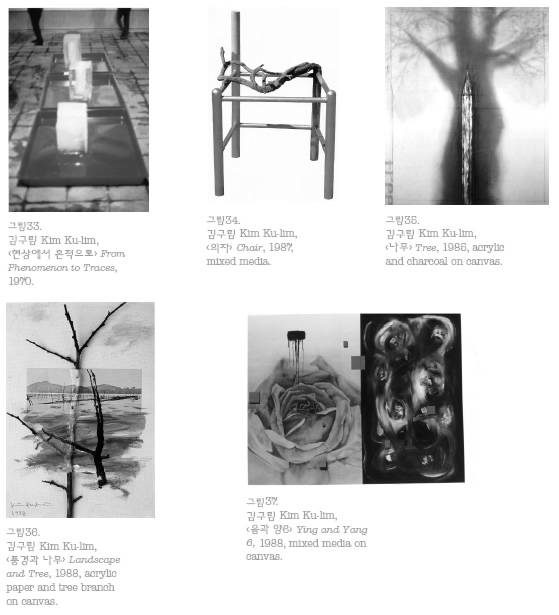
Through Kim Ku-lim’s works, in which different and contrasting signs are juxtaposed, signs deny each other. Because they are substitutes that circle around the unreachable substance, it can be said that everything in his works are saying ‘it is not ~’. Kim’s works are the visual diagrams of Ferdinand de Saussure’s idea that there are no positive terms that say ‘it is ~’, but only differences. Furthermore, given that that process is endlessly continued, Kim puts Derrida’s game of differance into practice, with time dimension added to it. Kim’s works are a textual space, in which the game of differance is being played, and that kind of space is a matrix of traces; traces of signs that are sent back from other signs and again entrusted to other signs. In the world of texts, where only “traces of traces” exist, there are no ultimate signified, but only relations of signifiers.
The fact that ‘substance’ or ‘presence’, a concept derived from traditional metaphysics, can’t exist in Kim Ku-lim’s works doesn’t preclude the existence of the world itself. As Derrida claimed, “differance iXs”, it exists as something that doesn’t exist. According to Lee U-fan, Kim Ku-lim’s works are a world of absent objects: ‘places that exist nowhere’, and ‘objects that are nothing. It is as if “absence”, a symbolic condition termed by Rosalind Krauss, is explicitly shown through Kim’s works. His paintings that, as a substitute of the substance of objects, wander around many different signifiers, are in fact texts which assert that one can never reach the substance, and thus there is no substance.
“There is no natural frame. There is frame. However, the frame does not exist.”
Kim Ku-lim’s works, in which the link between utterance and the subject of such utterance (work of art and its author), and the signifier and the signified (figure and meaning) is deconstructed, are basically asking what art is. Kim endlessly creates and juxtaposes various and different signifiers that represent ‘being art’, and by doing so loosens the string between the concept ‘art’ and its sample. By loosening the link of sameness in the categorical concept of ‘art’, Kim is deconstructing the very art itself. This act of deconstruction is blatantly visualized through the aspect of crossing the inner and outer side of existing concept of art. In other words, he is working on the boundary that separates art and non-art, which positions him on the same spot as Derrida who questioned the ‘frame’. Kim Ku-lim’s works reveal the frame as a ‘parergon’, as described by Derrida. By hanging between inside and outside of such frame, interest in the very frame and its ambiguity is aroused.
Upon deconstructing Immanuel Kant’s theory of art, Derrida brings the frame, which is “something that Kant’s theory of art does and doesn’t talk about... something that is owed and yet trying to be forgotten, a place of origin and disintegration”, into question. Thoughts of Kant as well as the whole modern philosophy have their purpose in building a frame to secure sameness, and Derrida, looking again the frame that lies outside of those conceptual thoughts, gives attention to the fact that such frame is parergon. According to Derrida, the frame, like a picture frame that has been left out in the border area of the artwork or its concept, is an attachment that decorates ergon, thus parergon. Derrida explains that such frame is a ghostly existence—owner of the master-key (passe-partout) which, without being capture by conceptual field of vision, closes and opens that very concept.42 In Derrida’s words, “parergon... manipulates, approaches, rubs, scrubs and presses that very concept. As much as the inside is empty, the more it becomes attached to the inside.”43 In other words, it (parergon), while being placed outside art, creates and relates to the inside.
Kim Ku-lim’s works reveal the figure or parergon, which is supplements and substitutes ergon; they reveal the topological ambiguity of the parergon which is neither inside nor outside, or which is inside and outside. Constantly crossing the boundaries of existing concepts of art, Kim exposes that such boundaries, while defining art, are also changeable and arbitrary.
First, Kim Ku-lim crosses the boundary of artwork and ordinary thing. Kim, like Marcel Duchamp, selects ordinary things, cast them in bronze like Jasper Johns and like Robert Rauschenberg, transform or combine them with artistic processed goods. In any case, duplexity of being ‘borrowed’ from everyday life and being ‘created’ in the field of art is exposed.
Bronze bottle that’s cast to resemble the actual bottle (picture 12) is a replica and an artwork at the same time. It’s figure is being borrowed from an existing product—and not made by the artist—but on the other hand, it’s a bronze sculpture. As it turns out to be, a single signifier connotes two opposite signifieds, ‘borrowing’ and ‘creating’. Series of bronze works are replicas of such objects as telephone, basketball and slipper are no exception to this. Furthermore, as the cast part and the traces of the author’s handworks are juxtaposed in these works, their ambilaterality becomes even more emphasized.
Works which contain real objects as their parts are literally crossing boundaries between borrowing and creating or everyday life and art. The can in 2 Cans (picture 24) is an actual can, but also a piece of artwork; it lies on a canvas, a space that is arranged for art, and it is colored by an artist. The shopping basket and the can in Still Life (1979) are also real objects, yet still life pieces that are placed on stand-like canvas at the same time. Considering the aspect of placing real objects on a flat surface, in Newspaper (1982), whose format is similar to above mentioned works, a real table substitutes the canvas. That table is not only a table with newspaper on it, but also a monochromatic picture with Korean paper used as texture.
After all, Kim Ku-lim is proposing signs that cross art and non-art, and this side is expanded to his object installation works in which the facet of actual things being placed in real spaces is emphasized. The brush and the light bulb which appears in Kim’s installation space (1973), are on the one hand actual things in real spaces, and on the other hand work of installation art that, together with their shadows drawn by him, compose the whole space. In the case of Broomstick and Dustcloth (picture 30), the installation space is comprised of a broomstick and a mop which are actual objects in a real space, and are processed to have a worn out look. Unlike Duchamp, Kim Ku-lim, rather than presenting actual things as they are, processes and displays them as ‘assisted ready-made’. Through this, the ambilaterality of actual thing and artwork is literally brought to surface. Taking a shovel, which was also used by Duchamp, Kim cuts and colors it to give a worn out look, setting it against the wall (picture 1, 2). If the object/art ambilaterality of Duchamp’s shovel is hidden in the concept of ‘ready-made’, such ambilaterality arises to the surface in Kim’s shovel. As a similar example, Chair (picture 42), which combines two objects, is a chair with a hammer on it, and also a picture of the spot where the hammer was on, drawn in yellow paint.
As such, Kim Ku-lim actively reveals the existence and non-existence of a boundary that divides things and art. Furthermore, as his works separates things into the natural and the ordinary, such boundary is applied to a more detailed classification, thus emphasizing its flexibility even more. In other words, it is shown that boundaries are present and absent at the same time, and may be set to be large, small and overlapping. Chair (picture 34) or Tree (1987) seemingly show the process of trees, raw material from nature, being reincarnated as artefacts such as chairs or pencils. These two are tree branches taken from nature, household items that are made with those branches, and are also works of art that are realized by the author’s conceptual intentions and handwork. From this relationship between nature and artefact, one may infer the relationship between artwork—one of those artefacts—and nature. Landscape (picture 45), in which twig and landscape is combined, the twig is a real thing in nature that makes for the landscape, and also an element of work of art, a landscape painting. Features such as brush strokes that go over the real twig, and thus make themselves part of the painting and the twig, or the shadow that is made by the real twig and also painted as an element of the landscape painting, all contribute to actively revealing the above mentioned matters.
These works can be interpreted as ‘parergon’, with the ‘frame’ that divides natural things, ordinary things and artworks being present and absent at the same time. Imagination (picture 45) is an example of such frame being visualized as a picture frame. As seen by the picture frame which is exposed beyond the painting, and yet supports the painting and covered by it at the same time, the picture frame is an outside factor that involves itself in the inside. Here, the twig goes around boundaries between art, everyday life and nature, while indicating the relationship of inside and outside. It unites together with the painting on the canvas, and yet becomes art and nature by piercing through it. At the same time, as the twig meets the picture frame that is exposed behind the painting, it reaches out to the outside material world. By crossing back and forth the frame that separates outside from the inside, it reveals and also denies the difference between them. Shadow of the twig painted on the picture frame implies that frame can be painting, and that it can be inside as well as outside. Such frame is parergon which, by being added to ergon, lets ergon be ergon.
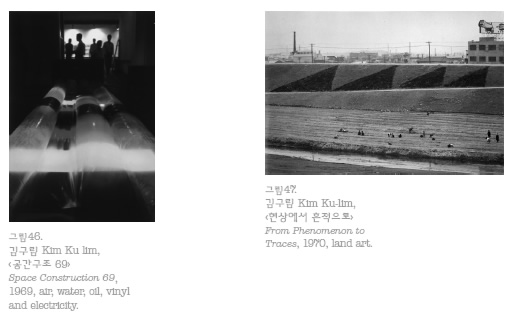
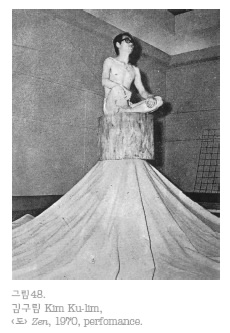 Come to think of it, “not many artists have done such strange works as Kim Ku-lim”48, a humble remark made by a critic once, is quite meaningful. It wouldn’t be an overstatement to sasy that Kim’s whole career, in which he pursued strangeness, in other words difference, was devoted to staying outside of orthodox art history and breaking down all sorts of frames. His works, which questioned the absoluteness of frame and the frame itself that determines author subject, its artworks and the concept of art, is not different from practicing philosophy through art, and more specifically practicing deconstructive philosophy through art. Kim’s works illustrate not art on deconstructionism, but “art as deconstructionism”. As opposed to applying deconstructionism to art, he practiced it through his works.
Come to think of it, “not many artists have done such strange works as Kim Ku-lim”48, a humble remark made by a critic once, is quite meaningful. It wouldn’t be an overstatement to sasy that Kim’s whole career, in which he pursued strangeness, in other words difference, was devoted to staying outside of orthodox art history and breaking down all sorts of frames. His works, which questioned the absoluteness of frame and the frame itself that determines author subject, its artworks and the concept of art, is not different from practicing philosophy through art, and more specifically practicing deconstructive philosophy through art. Kim’s works illustrate not art on deconstructionism, but “art as deconstructionism”. As opposed to applying deconstructionism to art, he practiced it through his works.
Kim Ku-lim’s statement, “is and is not a bottle at the same time”, reminds us of Derrida’s words on deconstruction, “affirm certain being together”. Here we find the positive point that lies within deconstructionism; the thoughts of ‘indeterminate’ and ‘anti-truth’. Kim’s works and Derrida’s way of thinking both enable “an escape out of this world”, the suffocating world which is filled with meanings. Through the world of “pure absence”, which belongs to nowhere, those that were erased and oppressed by the myth of oneness are ironically revived. Thus, as Christian Ruby’s expression, deconstruction forms an “archipelago of difference (les archipels de la différence), instead of an altitude of difference (les ilots de la différence)”. That is, instead of isolated ‘meanings’ that absolutize or realize the very difference with others, a ‘connection of meanings’, which is formed through grafting onto and separating from others, is being produced.
This methodology—continuously structuring a network of relationships through connecting differences rather than excluding them—of deconstruction resides outside of traditional Western metaphysics and, in this sense, anti-western. As put by Derrida, logocentricism, which is the subject of deconstruction, is ‘white mythology’ that provided an imaginary background to traditional Western metaphysics—and thus deconstruction means to deconstruct the Western way of thinking. In this context, it is no coincidence that recent researches connect Derrida’s decontruction philosophy to thoughts of Lao Tzu and Zhuang Tzu, and that a critic commented on Kim Ku-lim’s attitude to be Oriental. Perhaps Kim’s works, which have very western appearances, might be more oriental in their signifying process, compare to monochromatic paintings which have been decorated with rhetorics such as ‘oriental’ or ‘Korean’.
Kim, through many of his works, has put out nothing, and on the same time, he worked on his pieces by not working. Just as Derrida said, that ‘deconstruction’ itself will also be deconstructed, Kim Ku-lim’s deconstruction too will be deconstructed, and through this process, his works will last.


